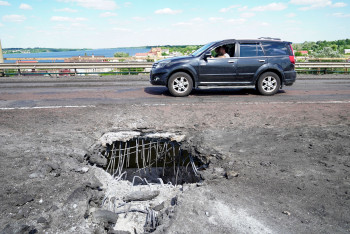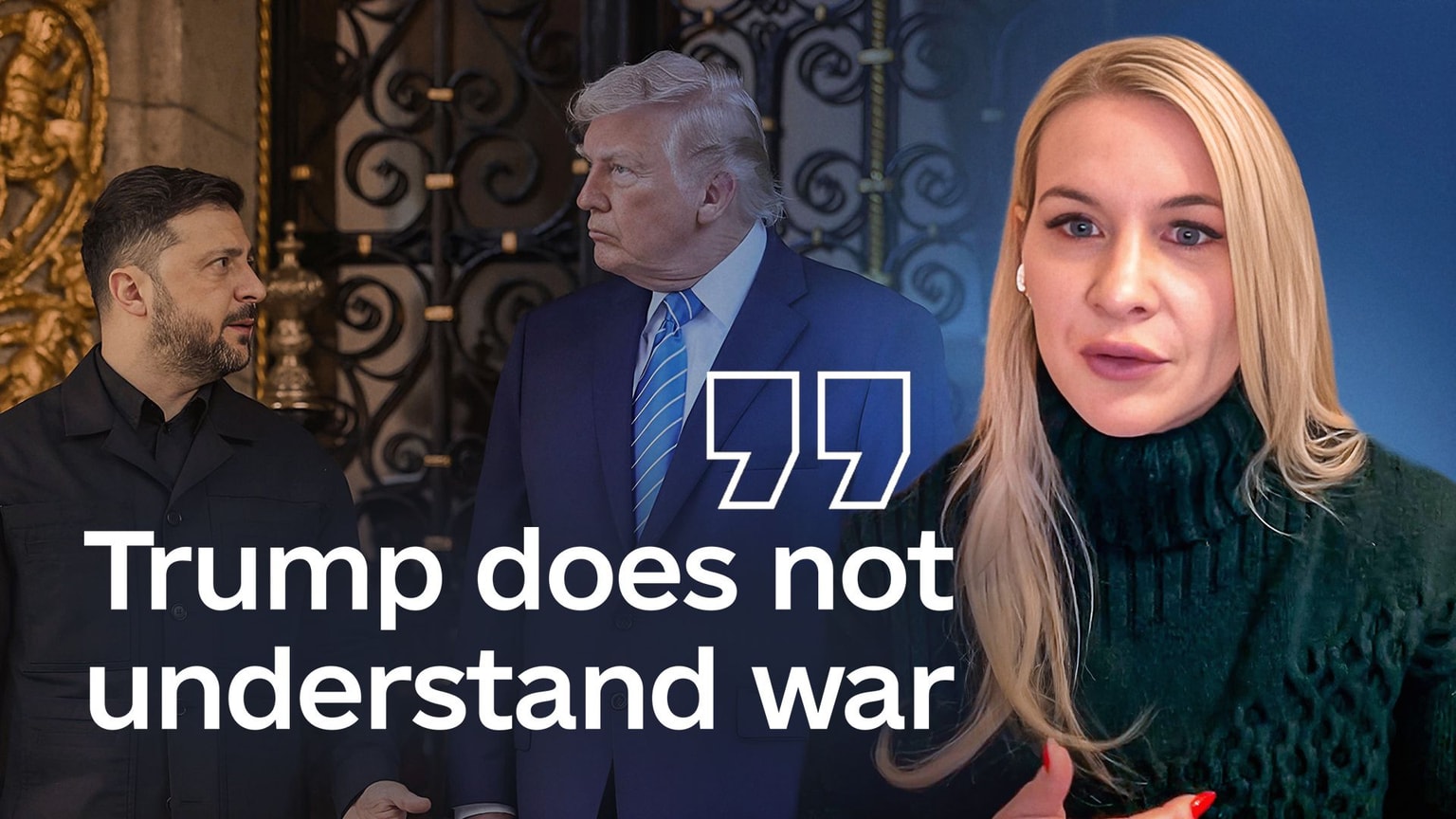General Marchenko: ‘Mykolaiv was to be next city to fall, but Russia terribly failed’

MYKOLAIV – After quickly occupying Kherson in the first days of the full-scale invasion, Russia turned its sight towards Mykolaiv, Ukraine’s shipbuilding center.
Many expected the regional capital of 480,000 people to fall next.
On Feb. 25, one day after Russia began its invasion and southern offensive, Major General Dmytro Marchenko was sent to his home region tasked with defending Mykolaiv. He has been in charge of the key city’s defense ever since.
“When I arrived, there were no checkpoints, no trenches,” Marchenko told the Kyiv Independent. “If nothing was done in the first days, Kherson’s fate would have awaited Mykolaiv.”
According to the general, even though the city was not prepared well for war, residents were ready to act fast.
“I was very happy to see that when we started digging trenches, locals shared their tools with our soldiers and even helped them,” Marchenko said.
In his interview with the Kyiv Independent, Marchenko explained how the city geared up for war, what are the chances of a successful counteroffensive in the south, and what Ukraine needs to end the war.
Defending Mykolaiv
Before the full-scale invasion, Marchenko was known for his active role in the Battle for the Donetsk Airport and the defense of the eastern town of Debaltseve in 2015. Both have eventually fallen to Russian-controlled forces.
In 2019, the State Investigation Bureau launched a probe into potential corruption against the general concerning providing the army with malfunctioning and overpriced bulletproof vests.
The case went nowhere, and Marchenko was redeemed in March 2022 when he received the Order for Courage for his role in defending Mykolaiv.
“The most important skills that we learned since the war started in 2014 is not to panic and have no fear when facing the (outnumbering) enemy,” Marchenko says, remembering how the Ukrainian army was created almost from scratch during the initial stages of the Russian invasion.
Yet Marchenko adds that the 2014 Russian invasion had very few similarities with what is happening now.
“Today’s war is completely different from the one we had before. Previously, battles were local, now they occur everywhere. Nowadays, the enemy uses its entire arsenal,” the general says.
Russian forces have conducted rocket strikes, artillery shelling, used ships, tanks, and every piece of equipment to inflict as much harm as possible on Ukrainian troops and civilians.
In early March, Russian forces tried to encircle Mykolaiv by rapidly entering the oblast from the east, south, and north.
Russian soldiers managed to capture the eastern road leading to the city, entering Mykolaiv’s outskirts on March 7. The Russians also entered Bashtanka, a small town 60 kilometers north of Mykolaiv.
“Bashtanka was a strategic point for the invaders to encircle the city,” Marchenko said.
According to the general, without taking Bashtanka it would have been impossible to encircle the city and cut it off from the main Ukrainian reserves.
“Locals have met the invaders with fierce resistance, burned their equipment, captured armored vehicles, and even managed to take prisoners,” Marchenko said, speaking of the battle for the city in early March.
As a result of stiff resistance and the timely Ukrainian military intervention, the city was kept under the Ukrainian flag.
Simultaneously, Ukrainian troops under Marchenko’s command were able to push Russians out of Mykolaiv’s outskirts.
“Mykolaiv was supposed to be the next city to fall under Russian occupation, but the enemy terribly failed at doing so,” he added.
By the end of March, most of the oblast’s lands returned under Ukraine’s control, and Russian troops were pushed back to Kherson Oblast.
“In the first days, locals were certain that the worst was inevitable, but a proper organization and an efficient strategy led us to victory,” Marchenko said.
Mykolaiv Oblast Governor Vitaliy Kim said that less than 5% of the oblast’s towns remain under Russian occupation.
Southern counteroffensive
Despite Ukraine’s successful defensive strategy in Mykolaiv, the country’s victories in the south remained mostly restricted to Mykolaiv Oblast, with Ukrainian troops only slowly starting to advance towards occupied Kherson in July.
“When we pushed the Russians out of Mykolaiv’s outskirts, it was impossible for us to move towards Kherson because we didn’t have the might and the proper military equipment to do so,” Marchenko said.
On July 10, Defense Minister Oleksii Reznikov announced that President Volodymyr Zelensky ordered the military to liberate the country’s entire south.
Marchenko was reluctant to give any details regarding the announced counteroffensive but added that it won’t be an easy task.
“It is hard to predict anything in such conditions. The Russians knew we were coming, so they switched to a more defensive strategy,” he says. “History and military experience show that for an army to succeed in an offensive, it needs to have at least three times the number of troops that the defending enemy has.”
“We are not Russia, and we don’t have the resources that they do,” he added.

Major General Dmytro Marchenko talks with the Kyiv Independent in Mykolaiv on Aug. 3, 2022. (Kostiantyn and Vlada Liberov)
According to Marchenko, Russian troops are well prepared to defend the regions they were able to seize in March, while also having the capacity to launch their own offensive towards Mykolaiv, again, in the future.
Marchenko says that Russians never renounced their goal to occupy the entire south.
“Both (Ukraine and Russia) have consequential casualties, but the main difference is that Russia can renew its military potential (in the long-run), and we can't,” he says.
According to Ukraine’s estimates, Russia has lost over 46,000 soldiers since Feb. 24. According to the Pentagon, 80,000 Russian troops have been wounded, killed, or captured in Ukraine as of Aug. 8.
Ukraine doesn’t publish its military casualties. However, on Aug. 22, Commander-in-Chief Valerii Zaluzhnyi said that Ukraine has lost “almost 9,000 heroes.”
Helping hand
Now, Marchenko says, Ukraine continuously asks for foreign military aid as it needs more heavy artillery and rocket launchers to tilt the war in Kyiv’s favor.
The U.S. Defense Secretary Lloyd Austin announced on July 20 that the U.S. would deliver four extra HIMARS rocket launching systems, meaning that a total of 16 of them would be given to Ukraine.
Ukraine also received a limited number of M270 MLRS.
“Foreign military aid completely changed the war. The problem is that we don’t receive enough of it. We get dozens of them, but we need hundreds,” Marchenko says.
“However, I am confident it is only a matter of time before we obtain it,” he adds. “The entire world wants this war to end as soon as possible,” says Marchenko, adding that the only way to achieve it is to arm Ukraine.
Now, the key objective of the Ukrainian Armed Forces is to cut off Russian forces from their supplies as much as possible.
That is why Ukraine is targeting Russia’s supply routes in the south, such as the Antonivsky Bridge in Kherson Oblast.
The latest artillery attack on Aug. 25 struck the largest bridge in the region across the Dnipro River, making it either barely usable or not usable at all.
Tens of Russian ammunition depots have also gone ablaze since June when Ukraine received its first batch of Western long-range artillery able to strike targets 80 kilometers deep.
Now the Ukrainian military say that the Russian-built Crimean Bridge over the Kerch Strait, which connects occupied Crimea and the Russian mainland, is also a legit military target.
“Destroying the Crimean Bridge will not just partially change the situation, it will completely change it. This will cut Russians from their main reserves,” Marchenko says.
Ukraine currently doesn’t have artillery or rocket power to target the bridge over 350 kilometers from the front line.
Motivation
Despite Marchenko admitting that Russia has more firepower, the general says Ukraine has something the opponent doesn’t: the will to fight until the end.
“We are defending our homes and families, whereas Russian troops were forced to come here. We have no other choice than to keep fighting. They do not want to fight, a lot of soldiers surrender,” Marchenko says.
In 2014, when Russia launched its initial assault, a major pro-Russian rally took place in the city, with thousands attending it. Marchenko admits that pro-Russian sentiments were not uncommon but says the full-scale invasion has changed that drastically.
“People I know that used to think that peace should be achieved at any price, or that Ukraine’s sovereignty doesn’t matter, contacted me as soon as the full-scale invasion started and asked me how they can help,” Marchenko says.
“Before, people mostly wanted peace at any cost. Now, they only want victory. It is a crucial difference in the mentality,” he adds. “If we don’t fight for our lands today, then our kids will. We cannot wait, we need to win and finish this war as soon as possible.”












